Coventry Patmore
Coventry Kersey Dighton Patmore (23 July 1823 – 26 November 1896) was an English poet[1] and critic best known for The Angel in the House, his narrative poem about the Victorian ideal of a happy marriage.
Coventry Patmore | |
|---|---|
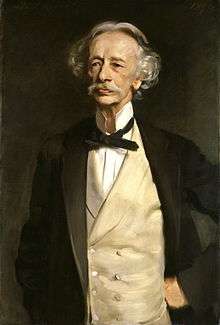 Portrait of Coventry Patmore, by John Singer Sargent, 1894. | |
| Born | Coventry Kersey Dighton Patmore 23 July 1823 Essex, England |
| Died | 26 November 1896 (aged 73) Lymington, England |
| Occupation | Poet and critic |
| Signature | |
As a young man, Patmore found employment in the British Museum. Upon the publication of his first book of poems in 1844, he became acquainted with members of the Pre-Raphaelite Brotherhood. After the death of his first wife, the grief of loss became in great measure his later theme. Patmore is today one of the least-known but best-regarded Victorian poets.
Life
Youth
The eldest son of author Peter George Patmore, Coventry Patmore was born at Woodford in Essex[2] and was privately educated. He was his father's intimate and constant companion and inherited from him his early literary enthusiasm. It was Coventry's ambition to become an artist. He showed much promise, earning the silver palette of the Society of Arts in 1838. In 1839 he was sent to school in France for six months,[3] where he began to write poetry. On his return, his father planned to publish some of these youthful poems; Coventry however had become interested in science, and poetry was set aside.
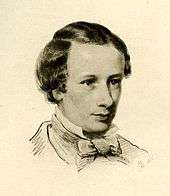
At this time Patmore's father was financially embarrassed; and in 1846 Richard Monckton Milnes obtained for Coventry the post of printed book supernumary assistant at the British Museum, a post he occupied for nineteen years, devoting his spare time to poetry. In 1847 he married Emily Augusta Andrews,[2] daughter of Dr. Andrews of Camberwell, and by 1851 they had had two sons, Coventry (born 1848) and Tennyson (born 1850). Three daughters followed – Emily (born 1853), Bertha (born 1855) and Gertrude (born 1857), before their last child, a son (Henry John), was born in 1860. Emily Andrews wrote children's stories.[3]
He later returned to writing however, enthused by the success of Alfred Tennyson; and in 1844 he published a small volume of Poems, which was original but uneven. Patmore, distressed at its reception, bought up the remainder of the edition and destroyed it. What upset him most was a cruel review in Blackwood's Magazine; but the enthusiasm of his friends, together with their more constructive criticism, helped foster his talent. The publication of this volume bore immediate fruit by causing its author to be introduced to various men of letters, including Dante Gabriel Rossetti, through whom Patmore became known to William Holman Hunt, and was thus drawn into the Pre-Raphaelite Brotherhood, contributing his poem "The Seasons" to The Germ.
In his time at the British Museum Patmore was instrumental in starting the Volunteer Movement in 1852. He wrote an important letter to The Times on the subject, and stirred up much martial enthusiasm among his colleagues. He also introduced academic David Masson to Emily Rosaline Orme, his wife's niece, both of whom were strong supporters for women's suffrage and rights.[4]
Major publications
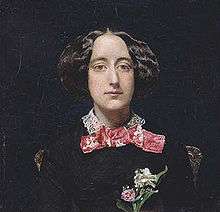
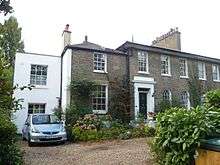
In 1853 he republished Tamerton Church Tower, the more successful of his pieces from Poems of 1844, adding several new poems which showed distinct advance, both in conception and treatment; and in the following year (1854) the first part of his best-known poem, The Angel in the House, appeared.[5][6][7] The Angel in the House is a long narrative and lyric poem, with four sections composed over a period of years: The Betrothed and The Espousals (1856) which eulogize his first wife; followed by Faithful For Ever (1860); and The Victories of Love (1862). The four works were published together in 1863 and have come to symbolise the Victorian feminine ideal[8] – which was not necessarily the ideal amongst feminists of the period.[9]
By 1861 the family was living in Elm Cottage, North End, Hampstead. On 5 July 1862[10] Emily died after a lengthy and lingering illness, and shortly afterwards Coventry joined the Roman Catholic church.
In 1865 he remarried, his second wife being Marianne Byles, daughter of James Byles of Bowden Hall, Gloucester, and a woman of considerable fortune as well as beauty; a year later he purchased Buxted Hall in Surrey, the history of which he wrote in How I managed my Estate (1886). In 1877 he published The Unknown Eros,[11] which contains his finest poetic work,[12] and in the following year Amelia, his own favourite among his poems, together with an interesting essay on English Metrical Law, appeared. This departure into criticism continued in 1879 with a volume of papers entitled Principle in Art, and again in 1893 with Religio Poetae.
His second wife Marianne died in 1880, and in 1881 he married Harriet Robson[2] from Bletchingley in Surrey (born 1840), his children's governess. Their son Francis was born in 1882.
Patmore had a deep friendship with the poet Alice Meynell, lasting several years, which led to his becoming obsessed with her, forcing her to break with him.[13]
In later years he lived at Lymington, where he died in 1896.[14] He was buried in Lymington churchyard.[15]
Evaluation
A collected edition of Patmore's poems appeared in two volumes in 1886, with a characteristic preface which might serve as the author's epitaph. "I have written little", it runs; "but it is all my best; I have never spoken when I had nothing to say, nor spared time or labour to make my words true. I have respected posterity; and should there be a posterity which cares for letters, I dare to hope that it will respect me." The sincerity which underlies this statement, combined with a certain lack of humour which peers through its naïveté, points to two of the principal characteristics of Patmore's earlier poetry; characteristics which came to be almost unconsciously merged and harmonized as his style and his intention drew together into unity.
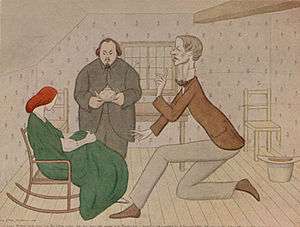
As happy love had been his earlier, the grief of loss became, in great measure, his later theme; touching and sublime thoughts upon love, death, and immortality are conveyed through strikingly poetic imagery and unusual form in the odes of The Unknown Eros, his best work. The collection is full not only of passages but entire poems in which exalted thought is expressed in poetry of the richest and most dignified melody.[2] Spirituality informs his inspiration; the poetry is glowing and alive. The magnificent piece in praise of winter, the solemn and beautiful cadences of "Departure", and the homely but elevated pathos of "The Toys", are in their manner unsurpassed in English poetry. His somewhat reactionary political opinions, which also find expression in his odes, find less praise today although they can certainly be said to reflect, as do his essays, a serious and very active mind. Patmore is today one of the least-known but best-regarded Victorian poets.
His son Henry John Patmore (1860–83) also became a poet.
Works
- Principles in Art. London: George Bell and Sons, 1889.
- Courage in Politics and other Essays. London: Oxford University Press, 1921.
Articles
- "William Barnes, the Dorset Poet," The Library Magazine, Vol. II, November 1886/March 1887.
- “Distinction,” The Eclectic Magazine, Vol. LII, 1890
- "Three Essayettes," The Eclectic Magazine, Vol. LVI, July/December 1892.
References and sources
- References
- "Coventry Patmore, the Poet of Love", The Literary Digest, 27 February 1897.
- Meynell, Alice. "Coventry Patmore." The Catholic Encyclopedia Vol. 11. New York: Robert Appleton Company, 1911. 4 June 2019

- "Coventry Patmore", Poetry Foundation
- Crawford, Elizabeth. (1999). The women's suffrage movement : a reference guide, 1866-1928. London: UCL Press. ISBN 0-203-03109-1. OCLC 53836882.
- "Mr. Coventry Patmore's Poems," The National Review, Vol. VI, January/April 1858.
- McSweeney, Kerry (2000). "The Angel in the House", Victorian Poetry, Vol. 38, Number 2, Summer.
- Hartnell, Elaine (1996). "'Nothing but Sweet and Womanly': A Hagiography of Patmore's Angel", Victorian Poetry, Vol. 34, No. 4, Coventry Patmore: 1823–1896. In Memoriam.
- Gosse, Edmund (1897). "The History of a Poem," The North American Review, Vol. 164, No. 484.
- Freiwald, Bina (1988). "Of Selfsame Desire: Patmore's The Angel in the House", Texas Studies in Literature and Language, Vol. 30, No. 4.
- "Advertising". South Australian Register (1839–1900). Adelaide. 13 September 1862. p. 2. Retrieved 28 September 2012 – via National Library of Australia.
- Page, Frederick (1917). "Coventry Patmore's 'Unknown Eros'", The Catholic World, Vol. CV, April/September.
- See Vesica piscis.
- Badeni, pp. 115–129.
- "Coventry Patmore Dead," The Catholic World, Vol. LXIV, October 1896/March 1897.
- Kerrigan, Michael (1998). Who Lies Where – A guide to famous graves. London: Fourth Estate. p. 74. ISBN 1-85702-258-0.
- Sources

- Meynell, Alice (1911). . In Herbermann, Charles (ed.). Catholic Encyclopedia. 11. New York: Robert Appleton Company.
- Garnett, Richard (1901). . Dictionary of National Biography (1st supplement). London: Smith, Elder & Co.
- Maynard, John. "Patmore, Coventry Kersey Deighton (1823–1896)". Oxford Dictionary of National Biography (online ed.). Oxford University Press. doi:10.1093/ref:odnb/21550. (Subscription or UK public library membership required.)
Further reading
- Betham-Edwards, Matilda (1911). "Coventry Patmore." In: Friendly Faces of Three Nationalities. London: Chapman & Hall, pp. 73–85.
- Bréguy, Katherine (1909–10). "Coventry Patmore," Part II, The Catholic World, Vols. XC/XCI, pp. 796–806, 14–27.
- Brooks, Michael (1979). "John Ruskin, Coventry Patmore, and the Nature of Gothic", Victorian Periodicals Review, Vol. XII, No. 4, pp. 130–140.
- Burdett, Osbert (1919), "Coventry Patmore", The Dublin Review: 245–260.
- ——— (1921), The Idea of Coventry Patmore, London: Oxford University Press.
- Cadbury, William (1966). "The Structure of Feeling in a Poem by Patmore: Meter, Phonology, Form", Victorian Poetry, Vol. IV, No. 4, pp. 237–251.
- Champneys, Basil (1900). Memoirs and Correspondence of Coventry Patmore, Vol. II. London: George Bell & Sons.
- Crook, J. Mordaunt (1996). "Coventry Patmore and the Aesthetics of Architecture", Victorian Poetry, Vol. XXXIV, No. 4, pp. 519–543.
- Dunn, John J. (1969). "Love and Eroticism: Coventry Patmore's Mystical Imagery", Victorian Poetry, Vol. VII, No. 3, pp. 203–219.
- Edmond, Rod (1981). "Death Sequences: Patmore, Hardy, and the New Domestic Elegy", Victorian Poetry, Vol. XIX, No. 2, pp. 151–165.
- Egan, Maurice Francis (1899). "The Ode Structure of Coventry Patmore." In: Studies in Literature. St. Louis, Missouri.: B. Herder, pp. 82–108.
- Fisher, Benjamin F. (1996). "The Supernatural in Patmore's Poetry", Victorian Poetry, Vol. XXXIV, No. 4, pp. 544–557.
- Fontana, Ernest (2003). "Patmore, Pascal, and Astronomy", Victorian Poetry, Vol. XLI, No. 2, pp. 277–286.
- Forman, H. Buxton (1871). "Coventry Patmore." In: Our Living Poets: An Essay in Criticism. London: Tinsley Brothers, pp. 257–271.
- Freeman, John (1917), "Coventry Patmore and Francis Thompson", The Moderns: Essays in Literary Criticism, Thomas Y. Crowell Co.
- ——— (1923), "Coventry Patmore", The North American Review, 218 (813).
- Garnett, Richard (1897), "Recollections of Coventry Patmore", The Living Age, XIII.
- ——— (1905), "Mr. Gosse on Coventry Patmore", The Bookman, XXVIII (163).
- Gelpi, Barbara Charlesworth (1996). "King Cophetua and Coventry Patmore", Victorian Poetry, Vol. 34, No. 4, Coventry Patmore: 1823–1896. In Memoriam.
- Gosse, Edmund (1897), "Coventry Patmore: A Portrait", The Living Age, XIII.
- ——— (1905), Coventry Patmore, Charles Scribner's Sons.
- Gwynn, Aubrey (1924). "A Daughter of Coventry Patmore", Studies: An Irish Quarterly Review, Vol. XIII, No. 51, pp. 443–456.
- Harris, Frank (1920). "Coventry Patmore." In: Contemporary Portraits. New York: Published by the author, pp. 191–210.
- Hind, C. Lewis (1922). "Coventry Patmore." In: More Authors and I. London: John Lane the Bodley Head, pp. 240–246.
- Johnson, Lionel (1911). "Coventry Patmore's Genius." In: Post Liminium: Essays and Critical Papers. London: Elkin Mathews, pp. 238–245.
- Latham, David (2012). "Coventry Patmore's Fine Line," The Journal of Pre-Raphaelite Studies, Vol. XXI, pp. 5–13.
- Leslie, Shane (1932). "Coventry Patmore." In: Studies in Sublime Failure. London: Ernest Benn, pp. 113–178.
- Lubbock, Percy (1908). "Coventry Patmore," Quarterly Review, Vol. CCVIII, pp. 356–376.
- Maynard, John (1996). "The Unknown Patmore", Victorian Poetry, Vol. XXXIV, No. 4, pp. 443–455.
- Meynell, Alice (1908). "Mr. Coventry Patmore's Odes." In: The Rhythm of Life and Other Essays. London: John Lane, the Bodley Head, pp. 89–96.
- Meynell, Alice (1922). "Coventry Patmore." In The Second Person Singular. London: Oxford University Press, pp. 94–109.
- O'Keefee, Henry E. (1920). "Coventry Patmore." In: Though and Memories. New York: The Paulist Press, pp. 30–54.
- Oliver, Edward James (1956). Coventry Patmore. New York: Sheed & Ward.
- Page, Frederick (1921), "Coventry Patmore: Points of View", The Catholic World, CXIII (678).
- ——— (1933), Patmore: A Study in Poetry, Oxford University Press.
- Patmore, Derek (1949). The Life and Times of Coventry Patmore. London: Constable.
- Pearce, Brian Louis (1996). "Coventry Patmore (1823–1896)", RSA Journal, Vol. CXLIV, No. 5467, pp. 69–71.
- Pierson, Robert M. (1996). "Coventry Patmore's Ideas Concerning English Prosody and "The Unknown Eros" Read Accordingly", Victorian Poetry, Vol. XXXIV, No. 4, pp. 493–518.
- Roberts, Gerald (2012). "Hopkins and Patmore: Tory Politics and Poetry", History Today, Vol. LXII, No. 1, pp. 30–36.
- Reid, John Cowie (1957). The Mind and Art of Coventry Patmore London: Routledge & Paul.
- Roth, Sister Mary Augustine (1961), Coventry Patmore's "Essay on English Metrical Law (PDF), The Catholic University of America Press.
- Russell, Matthew (1877). "Coventry Patmore," The Irish Monthly, Vol. V, pp. 529–537.
- Symons, Arthur (1920). "Coventry Patmore," The North American Review, Vol. CCXI, No. 771, pp. 266–272.
- Tovey, Duncan (1897). "Coventry Patmore." In: Reviews and Essays in English Literature. London: George Bell & Sons, pp. 156–168.
- Weinig, Mary Anthony (1981). Coventry Patmore. Boston: Twayne Publishers.
- Woodworth, Elizabeth (2006). "Elizabeth Barrett Browning, Coventry Patmore, and Alfred Tennyson on Napoleon III: The Hero-Poet and Carlylean Heroics", Victorian Poetry, Vol. XLIV, No. 4, pp. 543–560.
- Vere, Audrey de (1889). "Coventry Patmore's Poetry." In: Essays, Chiefly Literary and Ethical. London: Macmillan & Co., pp. 126–150
External links
| Wikisource has original works written by or about: Coventry Patmore |
| Wikiquote has quotations related to: Coventry Patmore |
| Wikimedia Commons has media related to Coventry Patmore. |
- Works by Coventry Patmore at Project Gutenberg
- Works by or about Coventry Patmore at Internet Archive
- Works by Coventry Patmore, at Hathi Trust
- Works by Coventry Patmore at LibriVox (public domain audiobooks)

- Poem of the Week: The Two Deserts by Coventry Patmore
- "Archival material relating to Coventry Patmore". UK National Archives.

- Coventry Patmore Collection at John J. Burns Library, Boston College